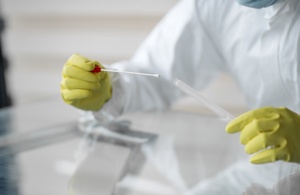Largest testing programme for coronavirus publishes its initial findings

Doctor taking a swab sample.
- Health Secretary welcomes initial findings from Imperial College London suggesting there was a significant reduction of the virus before lockdown restrictions were eased
- Findings provide a baseline for further research into how the virus is spreading in England
The Health Secretary has today welcomed the findings of the largest study to date into coronavirus rates of infection by Imperial College London.
The research, which examined levels of infection in the general population in England, has been posted by Imperial College London. The report will undergo peer review before a final report is published.
Imperial’s research shows the rates of infection fell during May, the last month of lockdown, halving every 8 to 9 days. There were on average 13 positive cases for every 10,000 people, with an overall reproduction number of 0.57 – lower than previously reported.
These findings show the virus was circulating with relatively low prevalence and was declining in May, ahead of the decision being made to begin to lift lockdown restrictions.
Health and Social Care Secretary Matt Hancock said:
This ambitious testing programme will help us better understand the spread of the virus to date, predict how it may spread in the future and inform our response to the pandemic.
It shows the impact our national lockdown efforts have had and demonstrates that we have taken the right actions at the right time.
As a country we have made great strides towards beating this virus but we mustn’t take our foot off the pedal, and such studies will be vital as we continue to fight this virus.
The report provides an insight into who was infected with the virus between 1 May and 1 June over lockdown, comparing geography, age, sex, ethnicity, key worker status and symptoms.
The key findings include:
- Young adults, aged 18 to 24, were more likely to test positive than other age groups, reinforcing the need for this age group to adhere to social distancing measures to protect vulnerable friends and family
- Those of Asian ethnicity were more likely to test positive than those of white ethnicity. It is possible that higher infection rates have contributed towards the higher death rates observed in this ethnic group
- Care home staff and healthcare workers were more likely to be infected with COVID-19 during lockdown than the general population, at a time when the public was following government advice to stay at home, therefore limiting their exposure to the virus. Those who had patient-facing roles were more likely to be in contact with known cases as part of their work
The report also shows anyone who had recent contact with a known COVID-19 case was 24 times more likely to test positive than those with no such contacts.
The NHS Test and Trace service is therefore playing an integral role in stopping the virus from spreading further having already contacted 130,000 people at risk of unwittingly transmitting the virus and advising them to self-isolate.
The Real-time Assessment of Community Transmission (REACT-1) programme is the largest, most significant piece of research looking at how the virus is spreading across the country.
It was commissioned by DHSC and carried out by a world-class team of scientists, clinicians and researchers at Imperial College London, Imperial College Healthcare NHS Trust and Ipsos MORI.





